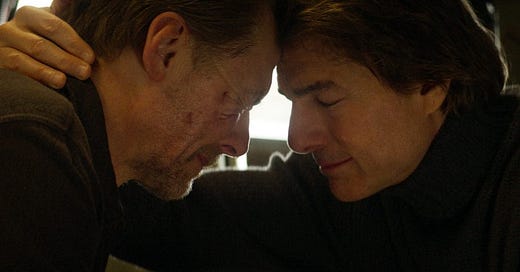Mission: Impossible – The Final Reckoning
The mileage will vary on reception, but one thing is for certain - Tom Cruise is not ready to give up the “King of Hollywood” mantle.
After a lifetime of near-death escapes, making sprinting as cool as ever, and several questionable hairstyles, we finally get to see what it all means for the incomparable Impossible Mission Force agent, Ethan Hunt (Tom Cruise), in the latest Christopher McQuarrie-directed “Mission: Impossible - The Final Reckoning.”
Although planted in a runtime of about 165 minutes, our latest installment in the “M:I” franchise attempts to reconcile the actions of Hunt over the last thirty years and how it has all impacted those he holds dear and those he will never know. To put it more simply, was “it” all worth it? The car chases, lives lost, Luther’s passionate monologues to Hunt, the incredulous face mask reveals, Hunt losing almost everyone and himself in the process—all of it.
As I would imagine for McQuarrie, Cruise, and the rest of the creative team, that question and the fate of the franchise weighed as heavy as ever.
Rather than jumping right into the ending sequences of “Mission: Impossible – Dead Reckoning,” we instead meet Hunt back in a familiar setting of hiding in the shadows, waiting. In this case, we see him receive a VHS tape with a message from now President Sloane (Angela Bassett). From what I perceive as more for the audience to “catch them up,” we get a prolonged mission brief from President Sloane. She briefs him not only on the current state of global affairs but, well, everything.
After the audience gets a montage of all of the missions, moments, villains, and love interests, we see Hunt reconvene with an ailing Luther (Ving Rhames) and Benji (Simon Pegg) in the underground of London.
Since the closing scenes of the previous movie, we knew that Luther would isolate himself to work on finding a “poison,” or an antivirus of sorts, to render useless the malevolent AI “The Entity.” As he prophesized for himself, he said it would take everything he had, and that is how we find him. He looks beat-up, has a rugged demeanor, and there is a medical bed arranged right next to his pop-up workstation. Nothing about the mission has changed from the last film, though. They must find Gabriel (Esai Morales) and, in turn, destroy The Entity.
Gabriel’s involvement in the situation is all too personal for him. As we learn from one oft-used flashback scene, it is effectively Gabriel who put Hunt in the situation to accept being part of the IMF all those years ago. Furthermore, we learn a shocking revelation about the origins of The Entity. This is not the first time that Hunt has crossed paths with it during his time in the IMF, and it is hammered home yet again that a certain choice made by Ethan led to The Entity being able to become what it is.
This inclination to remind the audience of the past incessantly dominates the first hour or so of the film. It became difficult to deny that this movie was holding the hand of the passive “Mission: Impossible” moviegoer. In the process, you see 30 years of hijinks and emotions lumped together to make sure everyone is "on the same page." Muddied in all parts of the film, you feel tonal shifts and the balancing of proverbial character arcs start to trump any illusion that this “Mission: Impossible” film is its own. For me, you see perhaps the first instance of a “Mission: Impossible” movie where its characters know they're in a “Mission: Impossible” movie.
The movie starts to get going when Hunt returns to the United States with the all-important cruciform-shaped key that offers humanity’s only chance to recover The Entity’s original source code. Simply, the only way to infiltrate The Entity. He is met at the Mount Weather military base in Virginia by President Sloane and her cabinet. Admittedly, the cabinet is played by a who’s who of characters that you say, “Oh, wow, they are in this.” You have some familiar faces (Charles Parnell, Indira Varma, and Mark Gattis) and some new ones (Nick Offerman and Holt McCallany).
Again, this movie never felt like a standalone product. One way that is felt is by the inclusion of new characters and extended screen time. The most glaring example is the reintroduction of Rolf Saxon as CIA Analyst William Donloe. Yes, the same person who Hunt and his team narrowly sidestepped back in the first “Mission: Impossible” movie during the CIA break-in.
Arguably the best part of the film is when Hunt has to retrieve The Entity’s source code. Located at the bottom of the Bering Sea, Ethan is left to make his way down to the sunken Sevastopol submarine that houses the source code.
The action sequences and near-death moments in the film represent something far more tangible in this film. In the previous installments, there was always that reassurance in the back of your mind that everything would be fine in the end. In this being the “Final Reckoning,” the same insurances are not necessarily present. The moments of peril and imminent doom resonated a little deeper.
The film will have a little bit of everything for all moviegoers. There are moments of jaw-dropping spectacle, Hunt defying orders, time almost running out, and even a somewhat trippy scene with Hunt and Grace (Haley Atwell) sharing a decompression chamber. I love this franchise, and this movie does not take away from all of the gut-wrenching, heart-pounding material of the prior installments. However, in a world centered around Hunt doing the impossible, I thought that Cruise & Co. played this movie’s story and plot structure all too safe.






https://substack.com/@egretlane/note/p-164695987?r=5ezmlv&utm_medium=ios&utm_source=notes-share-action